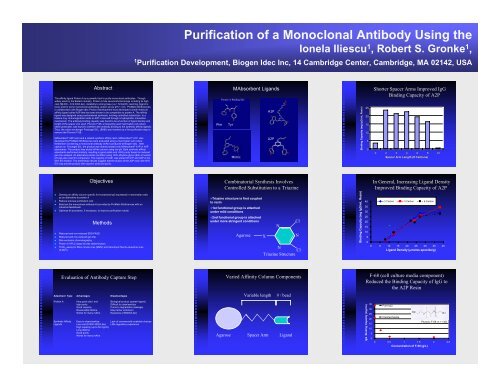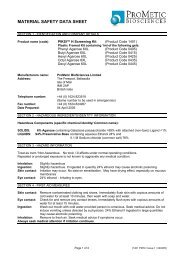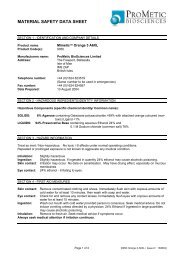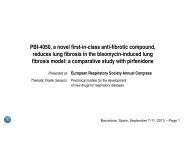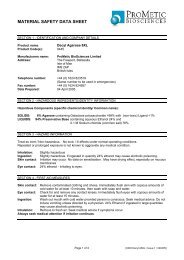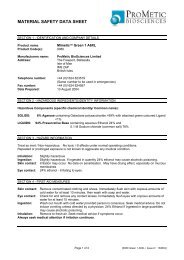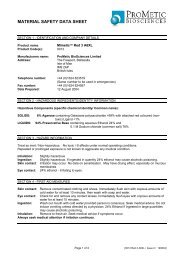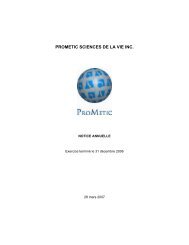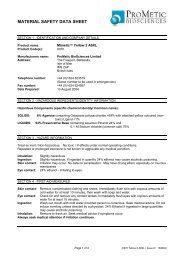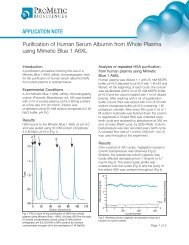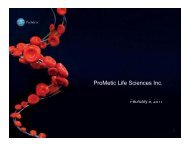Purification of a Monoclonal Antibody Using the
Purification of a Monoclonal Antibody Using the
Purification of a Monoclonal Antibody Using the
Create successful ePaper yourself
Turn your PDF publications into a flip-book with our unique Google optimized e-Paper software.
<strong>Purification</strong> <strong>of</strong> a <strong>Monoclonal</strong> <strong>Antibody</strong> <strong>Using</strong> <strong>the</strong><br />
Ionela Iliescu 1 , Robert S. Gronke 1 ,<br />
1 <strong>Purification</strong> Development, Biogen Idec Inc, 14 Cambridge Center, Cambridge, MA 02142, USA<br />
Abstract<br />
The affinity ligand Protein A is a powerful tool to purify monoclonal antibodies. Though<br />
widely used by <strong>the</strong> Biotech industry, Protein A has several shortcomings including its high<br />
cost ($9,000 – $12,000/Liter), instability to strong base (i.e.1 N NaOH), leaching (ligand is<br />
toxic) and for some monoclonal antibodies, elution at low pH (< 3.5). ProMetic BioSciences,<br />
in collaboration with Biogen Idec Product Development have developed a small molecule<br />
affinity ligand called A2P that has been shown to be competitive to protein A. The affinity<br />
ligand was designed using combinatorial syn<strong>the</strong>sis, involvig controlled substitution to a<br />
triazine ring. Immunoglobulin binds to A2P in low salt through a hydrophobic interaction<br />
mechanism. The antibody binding capacity was found to be a function <strong>of</strong> ligand density and<br />
length <strong>of</strong> <strong>the</strong> spacer arm used. Pluronic F-68, a frequently used mammalian cell culture<br />
shear protectant, was found to interfere with antibody binding to <strong>the</strong> syn<strong>the</strong>tic affinity ligands.<br />
Thus, <strong>the</strong> cation exchanger Fractogel SO - 3 (EMD) was inserted as a first purification step to<br />
remove <strong>the</strong> Pluronic F-68.<br />
MAbsorbent ® A2P resin and a related syn<strong>the</strong>tic affinity resin, MAbsorbent ® A1P, also<br />
developed by ProMetic BioSciences were evaluated using a mammalian cell culture<br />
feedstream containing a monoclonal antibody (mAb1) produced at Biogen Idec. After<br />
capture on Fractogel SO - 3 <strong>the</strong> product was directly loaded onto MAbsorbent ® A1P or A2P<br />
adsorbents. The product was eluted <strong>of</strong>f <strong>the</strong> column using low pH. Both syn<strong>the</strong>tic affinity<br />
adsorbents performed similarly, resulting in good yields and >95% purity based on reduced<br />
gel chip analysis. An alternative elution condition using 60% ethylene glycol (EG) at neutral<br />
pH was also used for comparison. The majority <strong>of</strong> mAb1 was eluted <strong>of</strong>f A1P and A2P in <strong>the</strong><br />
60% EG fraction. The preliminary results suggest that <strong>the</strong> elution <strong>of</strong> <strong>the</strong> A2P resin with 60%<br />
EG may provide product with superior yield and purity.<br />
MAbsorbent Ligands<br />
Protein A Binding Site<br />
A1P<br />
Phe Tyr<br />
A2P<br />
Mimic<br />
Binding Capacity (mg IgG/mL Resin))<br />
25<br />
20<br />
15<br />
10<br />
5<br />
0<br />
Shorter Spacer Arms Improved IgG<br />
Binding Capacity <strong>of</strong> A2P<br />
0 2 3 4<br />
6 8 12<br />
Spacer Arm Length (# Carbons)<br />
Objectives<br />
• Develop an affinity column specific for humanized IgG expressed in mammalian cells<br />
as an alternative to protein A<br />
• Reduce process purification cost<br />
• Beta test <strong>the</strong> monoclonal antibody kit provided by ProMetic BioSciences with an<br />
industrial feedstream<br />
• Optimize kit procedure, if necessary, to improve purification results<br />
Methods<br />
• Reduced and non-reduced SDS-PAGE<br />
• Reduced and non-reduced gel chip<br />
• Size exclusion chromatography<br />
• Protein A HPLC assay for titer determination<br />
• TCID 50 assay for Mice minute virus (MMV) and Xenotropic Murine leukemia virus<br />
(X-MLV)<br />
Combinatorial Syn<strong>the</strong>sis Involves<br />
Controlled Substitution to a Triazine<br />
•Triazine structure is first coupled<br />
to resin<br />
•1st functional group is attached<br />
under mild conditions<br />
•2nd functional group is attached<br />
under more stringent conditions<br />
Agarose<br />
X<br />
N<br />
Cl<br />
N<br />
N<br />
Cl<br />
Triazine Structure<br />
Binding Capacity (mg IgG/mL Resin)<br />
40<br />
35<br />
30<br />
25<br />
20<br />
15<br />
10<br />
5<br />
0<br />
In General, Increasing Ligand Density<br />
Improved Binding Capacity <strong>of</strong> A2P<br />
2 Carbon 3 Carbon 6 Carbon<br />
0 5 10 15 20 25 30 35 40<br />
Ligand Density (µmoles epoxide/g)<br />
Evaluation <strong>of</strong> <strong>Antibody</strong> Capture Step<br />
Adsorbent Type Advantages Disadvantages<br />
Varied Affinity Column Components<br />
Variable length # / bead<br />
F-68 (cell culture media component)<br />
Reduced <strong>the</strong> Binding Capacity <strong>of</strong> IgG to<br />
<strong>the</strong> A2P Resin<br />
Protein A Very good yield and Biological product (protein ligand)<br />
high purity<br />
Difficult to clean/sanitize<br />
Good capacity<br />
Prone to degradation (leakage)<br />
Reasonable lifetime<br />
May harbor endotoxin<br />
Works for many mAb’s Expensive (>$9000/Liter)<br />
Syn<strong>the</strong>tic Affinity Easy to clean/sanitize Lack <strong>of</strong> commercially available choices<br />
Ligands Low cost ($1000-3000/Liter) Little regulatory experience<br />
High capacity (up to 50 mg/ml)<br />
Long lifetime<br />
Good purity<br />
Works for many mAb’s<br />
Agarose Spacer Arm<br />
Ligand<br />
IgG Binding Capacity (mg/mL)<br />
35<br />
Pure IgG<br />
30<br />
25<br />
Clarified Media<br />
20<br />
Pluronic F-68 (n = 140)<br />
15<br />
10<br />
5<br />
0<br />
0 0.5 1 1.5 2 2.5<br />
Concentration <strong>of</strong> F-68 (g/L)
ProMetic BioSciences <strong>Monoclonal</strong> <strong>Antibody</strong> Kit<br />
Jim Pearson 2 , and Keith Watson 2<br />
2 ProMetic BioSciences Ltd., 211 Cambridge Science Park, Milton Road, Cambridge CB4 0ZA, UK<br />
Replacement <strong>of</strong> Protein A with Mabsorbent ®<br />
Cell Culture Suspension<br />
Protein A Chromatography<br />
Harvest<br />
Clarified Supernatant<br />
Cation Exchange Chromatography<br />
MAbsorbent Chromatography<br />
Elution <strong>of</strong> A1P and A2P with Low pH<br />
•A1P and A2P Eluates have similar purity with low pH elution<br />
•However, <strong>the</strong> purity can be fur<strong>the</strong>r improved<br />
Columns were eluted with pH 3.5 (elution 1), 3.0 (elution 2) and 2.0 (strip).<br />
Eluates analyzed by reduced SDS-PAGE.<br />
A1P<br />
A2P<br />
Virus Clearance on A2P <strong>Using</strong> 60%<br />
Ethylene Glycol Elution (pH 7.8)<br />
Virus<br />
Removal<br />
(log 10)<br />
Inactivation<br />
(log 10)<br />
Total<br />
Clearance<br />
(log 10)<br />
MMV 4.9 < 1 4.9<br />
X-MLV > 3.7 2.0 > 5.7<br />
Fur<strong>the</strong>r purification/Formulation<br />
pH 3.5<br />
Elution<br />
pH 3.5<br />
Elution<br />
Kit Strategy for <strong>Purification</strong> <strong>of</strong><br />
<strong>Monoclonal</strong> Antibodies<br />
Clarified Culture Supernatant<br />
Adjust to pH 6<br />
Capture with Fractogel EMD SO 3<br />
-<br />
(cation exchange)<br />
Elute with 0.5 M NaCl<br />
<strong>Purification</strong> with MAbsorbent ® A1P/A2P<br />
Product/Analysis<br />
Elute with low pH<br />
Elution <strong>of</strong> A1P, A2P and rProtein A at pH 3.5<br />
% Total Half <strong>Antibody</strong> by NR Gel Chip<br />
20<br />
17.5<br />
A “half antibody”<br />
15<br />
variant was cleared<br />
10.7<br />
more efficiently by<br />
9.8 9.5<br />
A<br />
B<br />
<strong>the</strong> syn<strong>the</strong>tic affinity<br />
10<br />
ligands compared to<br />
rProtein A resin.<br />
5<br />
0<br />
IEX A1P Eluate A2P Eluate rPA Eluate<br />
% Aggregate by SEC<br />
25<br />
20.4<br />
Aggregate level with<br />
20 C<br />
D<br />
A2P or A1P was<br />
15<br />
much lower than that<br />
9.4<br />
<strong>of</strong> rProtein A eluate<br />
10<br />
4.1 4.0<br />
5<br />
0<br />
IEX A 1P Eluate A2P Eluate rPA Eluate<br />
Conclusions<br />
• Development <strong>of</strong> syn<strong>the</strong>tic affinity resin<br />
Optimized spacer arm length and ligand density increased <strong>the</strong> binding<br />
capacity <strong>of</strong> A2P with pure IgG<br />
Fractogel EMD SO 3- used as <strong>the</strong> capture step if feedstream contains<br />
pluronic F-68<br />
• Evaluation <strong>of</strong> syn<strong>the</strong>tic affinity resins (A1P and A2P) for purification<br />
<strong>of</strong> mAb1<br />
Lower pH <strong>of</strong> clarified cell culture supernatant required for efficient<br />
capture <strong>of</strong> mAb1 on Fractogel EMD SO -<br />
3<br />
Evaluation <strong>of</strong> alternative elution conditions: low pH or 60% ethylene<br />
glycol at neutral pH<br />
Preliminary results indicate that elution <strong>of</strong> A2P with 60% ethylene<br />
glycol at neutral pH may provide superior yield and purity<br />
60% EG elution step gave good clearance <strong>of</strong> MMV and X-MLV<br />
• Cost analysis: two-step non-Protein A purification was<br />
approximately 50% <strong>the</strong> cost <strong>of</strong> Protein A process<br />
Results – <strong>Purification</strong> <strong>of</strong> mAb1<br />
•Poor capture <strong>of</strong> mAb1 on Fractogel SO 3- at pH 6.0<br />
•Capture <strong>of</strong> mAb1 improved at pH 4.7<br />
Fractogel – Load at pH 4.7<br />
Alternative Elution: 60% Ethylene Glycol<br />
Elution, pH 7.8<br />
Higher product yield and purity with A2P than with A1P<br />
Columns were eluted with 60% EG (pH 7.8) followed by elution with pH 3.5 (elution 1),<br />
3.0 (elution 2), and 2.0 (strip). Fractions analyzed by reduced SDS-PAGE.<br />
A1P<br />
Loss <strong>of</strong><br />
Product<br />
A2P<br />
Removal <strong>of</strong><br />
impurities<br />
Acknowledgments<br />
Biogen Idec Inc.<br />
Prometic BioSciences Ltd.<br />
Douglas Cecchini, Ph.D. Dev Baines, Ph.D.<br />
Jörg Thömmes, Ph.D.<br />
Michael Duell<br />
Anisa Vaidya<br />
Peter Bonnett<br />
Christine Poliks<br />
Steve Burton<br />
Light<br />
Chain Loss<br />
Light<br />
Chain Loss<br />
Primedica<br />
Kate Bergmann<br />
60% EG Eluate 60% EG Eluate


